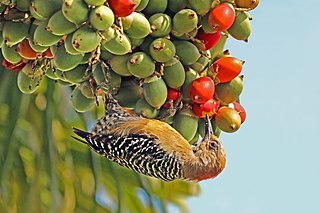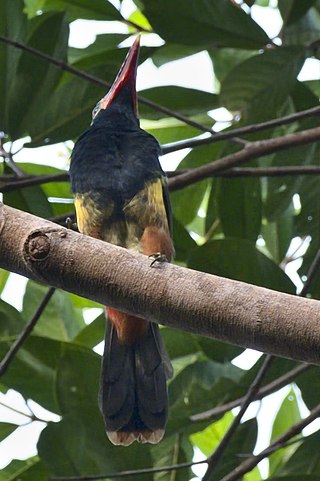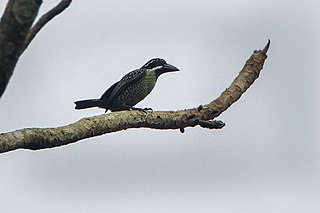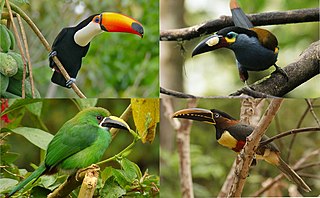
Nine families of largely arboreal birds make up the order Piciformes, the best-known of them being the Picidae, which includes the woodpeckers and close relatives. The Piciformes contain about 71 living genera with a little over 450 species, of which the Picidae make up about half.

The New World barbets are a family, Capitonidae, of 15 birds in the order Piciformes, which inhabit humid forests in Central and South America. They are closely related to the toucans.

Honeyguides are a family birds in the order Piciformes. They are also known as indicator birds, or honey birds, although the latter term is also used more narrowly to refer to species of the genus Prodotiscus. They have an Old World tropical distribution, with the greatest number of species in Africa and two in Asia. These birds are best known for their interaction with humans. Honeyguides are noted and named for one or two species that will deliberately lead humans directly to bee colonies, so that they can feast on the grubs and beeswax that are left behind.

The bearded barbet is an African barbet. Barbets are birds with a worldwide tropical distribution, although New World and Old World barbets are placed in different families. The barbets get their name from the bristles which fringe their heavy bills.

The greater honeyguide is a bird in the family Indicatoridae, paleotropical near passerine birds related to the woodpeckers. Its English and scientific names refer to its habit of guiding people to bee colonies. Claims that it also guides non-human animals are disputed.

The white-throated toucan is a near-passerine bird in the family Ramphastidae found in South America throughout the Amazon Basin including the adjacent Tocantins and Araguaia River drainage. It prefers tropical humid forest, but also occurs in woodland and locally in riverine forest within cerrado.

Lybiidae is a family of birds also known as the African barbets. There are 42 species ranging from the type genus Lybius of forest interior to the tinkerbirds (Pogoniulus) of forest and scrubland. They are found throughout sub-Saharan Africa, with the exception of the far south-west of South Africa.

The green araçari, is a toucan, a near-passerine bird. It is found in the lowland forests of northeastern South America, in the northeast Amazon Basin, the Guianas and the eastern Orinoco River drainage of Venezuela. At 30–40 cm. (12–16 in) long and weighing 110–160 grams, it is the smallest aracari in its range, and among the smallest members of the toucan family.

The pallid honeyguide is a species of bird in the family Indicatoridae. The species is also known as the eastern least honyeguide. It is found in Angola, Democratic Republic of the Congo, Kenya, Malawi, Mozambique, Tanzania, Uganda, Zambia, and Zimbabwe.

The double-toothed barbet is a species of bird in the family Lybiidae. It is found in Angola, Benin, Burundi, Cameroon, Central African Republic, Republic of the Congo, Democratic Republic of the Congo, Ivory Coast, Equatorial Guinea, Ethiopia, Gabon, Ghana, Guinea, Guinea-Bissau, Kenya, Liberia, Mali, Nigeria, Rwanda, Sierra Leone, South Sudan, Tanzania, Togo, and Uganda. Within Lybius bidentatus, there are two subspecies: Lybius bidentatus bidentatus and Lybius bidentatus aequatorialis.

The black-billed barbet is a species of bird in the Lybiidae family.
The yellow-footed honeyguide is a species of bird in the family Indicatoridae. It is found in Cameroon, Guinea, Liberia, Sierra Leone, Ivory Coast, Ghana and Nigeria. Its natural habitat is subtropical or tropical moist lowland forests. It is threatened by loss of its forest habitat.

The Guianan toucanet, or Guyana toucanet is a near-passerine bird in the toucan family Ramphastidae. It is found in Brazil, French Guiana, Guyana, Suriname, and Venezuela.

Gould's toucanet is a near-passerine bird in the toucan family Ramphastidae. It is found in Bolivia and Brazil.

The tawny-tufted toucanet is a near-passerine bird in the toucan family Ramphastidae. It is found in Brazil, Colombia, Venezuela, and possible Guyana.

The yellow-eared toucanet is a near-passerine bird in the toucan family Ramphastidae. It is found from Honduras to Ecuador.

The hairy-breasted barbet is a species of bird in the family Lybiidae. It is found throughout the Africa tropical rainforest.
Lester Leroy Short is an American ornithologist. His main research field is the order Piciformes.

Toucans are Neotropical birds in the family Ramphastidae. The Ramphastidae are most closely related to the Toucan barbets. They are brightly marked and have large, often colorful bills. The family includes five genera and over 40 different species.

Ramphastides is an infraorder of the order Piciformes that includes toucans and barbets. Formerly, the barbets have been classified in a single family, the Capitonidae. However, this has turned out to be paraphyletic with regard to toucans, which resulted in the Capitonidae being split into several families.
















